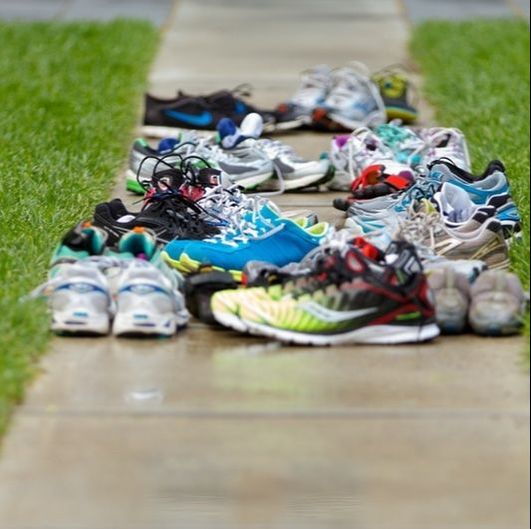| Ideas about running shoes have changed many times. Barefoot or sandals was the go for centuries. Then folks wore ordinary shoes, slightly lighter versions or footwear from other sports. The shift from plimsol type shoes to what most people have come to recognise as running shoes didn’t happen until the 1970s. From there we saw the increasing application of technical design/engineering ideas to what runners put on their feet. That’s where we get the mish-mash of gel’s, X-this and lite that. It’s a vicious arms race for differentiation, a lot of it with little or no scientific or physiological merit. |
The pendulum has swung the other way, and many of folk who ran in the minimal offerings of a few years ago, are now the same people running in the maximal offerings of today. When companies enter the market place and start throwing money around, without a principled approach to buying shoes, people will fall for anything.
In the USA alone, the athletic footwear industry is worth in excess of fourteen billion dollars. A multiple billion dollar industry based on a hypothesis.
Hypothesis, is of course the first step towards research, and the hypotheses of the 1960s and 70s around controlling the pronation of the foot to reduce injury were understandable. Though time and time again research has failed to find any proof in this hypothesis.
With the above in mind, here are some things to consider when buying your next pair of shoes:
Anatomy. Some practitioners, ad agencies and footwear brands would have us believe that more than 80% of the population have an abnormal foot that needs structural correction. It is more likely that less than 2% of the population have genetic defects that need structural correction.
TIP: If you have serious health concerns that your feet are genetically abnormal, see your doctor, not a shoe salesman.
Lifestyle. You will likely be spending far more time in shoes for work/casual purposes than you will in athletic footwear. You don’t want to spend the majority of your days in an achilles shortening, foot deforming, joint immobilising, sensory deprivation chamber. If you do, attempting to run in a shoe that is flat, flexible, shaped like a foot, and close to the ground is going to be far more challenging, and likely to end in tears.
TIP: Apply all the following principles to the shoes you wear for work and casual purposes for a period of time before applying it to your running shoes.
Flexibility. The human foot has twenty six bones, thirty three joints, and three arches. It is perfectly equipped to adapt to a constantly changing environment. You never take the same step twice. The surface underfoot is slightly different with every step you take. Your foot is perfectly equipped to adjust accordingly.
TIP: Look for a shoe that is flexible enough to allow your foot to function according to its structure.
Space. The natural shape of your foot plays an important role in balance and stability. The vast majority of western shoes are shaped based on fashion and/or tradition, and as such are narrower than the foot at the front, and squeeze the toes together. The result is a progressive deformation of the forefoot leading to a decrease in stability and balance.
TIP: Look for a shoe that allows some room for your toes to spread.
Feeling. The human foot has an extremely high concentration of nerve endings. They create a continuous fast feedback loop between the sole of the foot, the brain and the rest of the body. When a foot touches the ground it is searching for this proprioceptive feedback. Your muscles then adjust to control your position. This system works best with as little interference as possible.
TIP: Look for a shoe that is as thin soled as you can handle. Of course, this will be different for each situation.
Flatness. If your heel is raised off the ground the centre of gravity moves forward, and the pelvis rotates forwards. The greater the pitch of a shoe, the more this happens. Long term, this shortens and tightens the hip flexors, achilles tendon and soleus (deep calf muscle). The initiator of the running movement is the hamstrings group. The hamstrings are more difficult to contract as the pelvis rotates forwards.
The pitch of a shoe is really the difference between the height of the padding at the back and whatever’s under the forefoot at the front. The tricky part is working this out accurately, as there can be all sorts of padding tucked away in there subtly changing things. But this is simplified if you consider the steeper the pitch the more your achilles will shorten, which will make you more susceptible to injury.
TIP: Look for a shoe that is as flat as you can handle.
If over the last ___ (insert your age) years your feet have become deformed, immobile, weak, and proprioceptively unaware it is going to be more challenging to apply the above principles. The good news is it is probable that with time, patience and consistent action, you can normalise anatomy, increase the proprioceptive awareness, strengthen and mobilise the foot.
Your chosen shoes will not magically make you a better runner. They will not make you immune from injury. In fact, if you switch from highly padded and pitched shoes to flat, thin soled shoes you are likely to encounter some physical challenges. This is especially the case if your ‘supportive’ shoes have been supporting a poor running posture.
You don’t need extra support or rigidity to run on uneven trails. I suggest that harder shoes that immobilise your feet are more likely to cause injury, not less. What you need in those conditions is more feeling, not less, to be able to feel your way through the terrain.
Regardless of the shoe, I suggest that everyone should learn to run as efficiently as possible. I suggest that the more you can feel through the soles of your feet, the more likely you are to be aware of the way that you run.
If your goal is to be able to run efficiently for years to come, then making this change is a vital investment.
As you have probably worked out the way people move, and the shoes that they wear are two very important topics for me. If you'd like to keep tabs on my latest thoughts, make sure you subscribe to receive regular James Kuegler Coaching articles. Along the same lines, I would also love to help you with your technique, and would love to have you along to a James Kuegler Coaching event near you.




